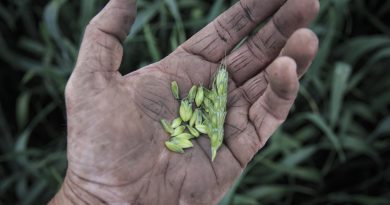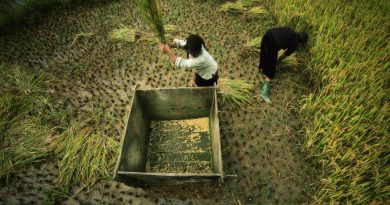The tree that shaped human history
Over 2,000 years ago, an important tree had one of its branches removed on the order of Indian emperor Ashoka the Great. It was under this very tree that the Buddha is said to have attained enlightenment. Ashoka bestowed kingship on the branch, and planted it in a thick-rimmed solid gold vase.
He then took the branch over mountains and down the Ganges River to the Bay of Bengal. There, his daughter carried it aboard a ship and sailed for Sri Lanka to present it to the king. Ashoka loved the plant so much that he shed tears as he watched it leave.
This story, from the epic poem The Mahavamsa, is about a kind of fig tree scientists call Ficus religiosa. True to its name, an unbroken line of devotion towards it stretches back to thousands of years before Ashoka’s time.
But F. religiosa is not alone. It is just one of more than 750 fig species. No other plants have held such sway over human imagination. They feature in every major religion and have influenced kings and queens, scientists and soldiers. They played roles in human evolution and the dawn of civilisation. These trees have not only witnessed history; they have shaped it. If we play it right, they could even enrich our future.
Most flowering plants display their blooms for all to see, but the Ficus species hide them away inside their hollow figs. And while most plants bury their roots underground, the strangler figs and their kin show them off.
They can even smother and kill giant trees, growing into colossal forms
The strangler figs are awesome plants that grow from seeds dropped high on other trees by passing birds and mammals. By starting out high in the forest canopy instead of on its gloomy floor, the strangler seedlings get the light they need to grow with vigour. As they do, they send down aerial roots that become thick and woody, encasing their host trees in a living mesh. They can even smother and kill giant trees, growing into colossal forms.
Two countries have placed a strangler fig on their coats of arms. In Indonesia’s case, the tree symbolises unity from diversity, its dangling roots representing the many islands that comprise the nation.
In the case of Barbados, it was inspired by the view that greeted the Portuguese explorer Pedro a Campos, when his ship reached the island in 1536. He saw many strangler figs growing along the island’s coast, a kind called Ficus citrifolia. Masses of ruddy-brown roots hung from their branches like matted strands of hair. A Campos named the island Los Barbados – “the bearded ones”.
Ashoka the Great’s daughter Sanghamitta accompanying the sacred fig tree to Sri Lanka (Credit: Photo Dharma/CC by 2.0)
More than 300 years later, the British biologist Alfred Russel Wallace was exploring islands on the other side of the word. He said the strangler figs he saw during his eight-year odyssey across the Malay Archipelago were “the most extraordinary trees in the forest”. How they overcame their struggle for existence inspired him as he developed the theory of evolution by natural selection, independently of Charles Darwin.
But the strangler figs had reached into human minds long before these European explorers took to the seas.
Take Ashoka the Great’s F. religiosa. Buddhists, Hindus and Jains have revered this species for more than two millennia. The same tree featured in battle hymns sung by the Vedic people 3,500 years ago. And, 1,500 years earlier, it appeared in the myths and art of the Indus Valley Civilisation.
Elsewhere in Asia — indeed across the tropics and subtropics — cultures have adopted fig trees as symbols of power and places of prayer. These figs feature in creation stories, folklore and fertility rites. The champion is the Indian banyan (Ficus benghalensis), a tree so big it can resemble a small forest from afar.
Buddhists, Hindus and Jains have revered F. religiosa for more than two millennia (Credit: Image Broker/Alamy)
Banyans grow so large because the roots they drop from their branches can merge into stout pillars as thick as English oak trees. These false trunks support the banyan’s huge branches, enabling them to grow longer and send down even more roots.
One banyan in Uttar Pradesh is said to be immortal. Another in Gujarat is said to have grown from a twig used as a toothbrush. A third is believed to have sprung up where a woman threw herself onto her husband’s burning funeral pyre and died. That tree, in Andhra Pradesh, can shelter 20,000 people.
The first Europeans to enjoy a banyan’s shade were Alexander the Great and his soldiers, who arrived in India in 326 BCE. Their tales of this tree soon reached the Greek philosopher Theophrastus, the founder of modern botany. He had been studying the edible fig, Ficus carica.
Each Ficus species has its own wasp pollinator
Theophrastus had noticed tiny insects entering or emerging from figs. Their story would turn out to be one of the most astounding in all of biology. More than 2,000 years would pass before scientists realised that each Ficus species has its own wasp pollinator, while some even have two. Likewise, each fig-wasp species can only lay its eggs in the flowers of its partner figs.
This relationship began more than 80 million years ago and has shaped the world ever since. Ficus species must produce figs year-round to ensure their pollinator wasps survive. This is great news for fruit-eating animals that would otherwise struggle to find food for much of the year. Indeed, figs sustain more species of wildlife than any other kinds of fruit.
More than 1,200 species eat figs, including one-tenth of all the world’s birds, nearly all known fruit-bats and dozens of species of primates, dispersing their seeds as they do so. Ecologists therefore call figs “keystone resources”. Like the keystone of a bridge, if figs disappeared everything else could come crashing down.
Figs do not only nourish animals. The year-round presence of ripe figs would have helped sustain our early human ancestors.
High-energy figs may have helped our ancestors to develop bigger brains. There is also a theory that suggests our hands evolved as tools for assessing which figs are soft, and therefore sweet and rich in energy. While the first humans benefitted from fig biology, their descendants mastered it. Ficus species are among the first plants people domesticated, several thousand years ago.
Farmers even trained monkeys to climb trees and harvest them
The ancient Egyptians seized upon a species called Ficus sycomorus, whose pollinator wasp was either locally extinct or had never arrived. By rights, this species should not have yielded a single ripe fig. But through a stroke of luck or genius, farmers worked out that they could trick the tree into ripening its figs by gashing them with a blade. Before long, the figs were a mainstay of Egyptian agriculture. Farmers even trained monkeys to climb trees and harvest them.
Egypt’s fig trees fed both bellies and beliefs. The Pharaohs took dried figs to their graves in order to sustain their souls on their journey into the afterlife. They believed the mother goddess Hathor would emerge from a mythic fig tree to welcome them into heaven.
To the north and east, the Egyptian fig’s sweeter cousin, F.carica, became an important food to several other ancient civilisations. The Sumerian King Urukagina wrote about them nearly 5,000 years ago. King Nebuchadnezzar II had them planted in the hanging gardens of Babylon. King Solomon of Israel praised them in song. The ancient Greeks and Romans said figs were heaven-sent.
Their allure can perhaps be explained by another crucial point. Aside from being sweet and tasty, they are also packed with fibre, vitamins and minerals.
These nutritional benefits have long been known. “Figs are restorative,” wrote 1st-century Roman philosopher Pliny the Elder, “and the best food that can be taken by those who are brought low by long sickness.”
A living bridge formed from the roots of two Ficus elastica fig trees (Credit: AditiVerma/CC by 2.0)
A famous example of the healing power of figs appears in the Bible. Hezekiah, King of Judah, was “sick even to death” with a plague of boils but recovered after his servants applied a paste of crushed figs to his skin.
These chimps may have been self-medicating
The healing power of fig species is not limited to their fruit. Medicines developed over millennia by people throughout the tropics make use of their bark, leaves, roots and latex.
The use of fig trees as living medicine cabinets may even pre-date the origin of our species. Our closest living relatives, chimpanzees, also appear to turn to these trees for their curative powers, suggesting our common ancestor with them did too.
Researchers working in Uganda occasionally observed chimps eating unusual foods, such as the bark and leaves of wild fig trees. These chimps may have been self-medicating, the researchers concluded. And for good reason, tests show that compounds in the fig leaves and bark are effective against bacteria, parasites and tumours.
Fig trees have not only helped civilisations and cultures rise. They have also watched them fall, and have even helped to hide their ruins.
For instance, the great cities of the Indus Valley Civilisation boomed between 3300 and 1500 BCE, but they were lost to history until 1827, when a deserter on the run from the East India Company called Charles Masson arrived there.
The fig trees helped forests return and overwhelm the abandoned buildings
Giant strangler trees dominated the landscape. Ruins poked out of mysterious mounds. Local people told Masson they were relics of a society that collapsed after some divine intervention corrected the “lusts and crimes of the sovereign”. In fact, it was a prolonged drought that brought down the Indus Valley Civilisation.
Strangler figs also replaced drought-stricken people at the Mayan pyramids at Tikal in Guatemala, and the Khmer temples of Angkor Wat in Cambodia.
In each case, the fig trees helped forests return and overwhelm the abandoned buildings. Their seeds germinated in cracks in the stonework. Their roots ripped masonry apart and crushed walls with their weight. Their figs attracted animals that in turn dispersed seeds of dozens of other tree species. And so, the forest reclaimed these sites.
This power has also been observed on volcanoes like Krakatoa, whose 1883 eruption purged the island of all life. Fig trees that recolonised the bare lava were instrumental in encouraging forest to form anew. Across the tropics scientists are now replicating this effect, planting fig trees to accelerate rainforest regeneration in areas where trees have been lost due to logging.
All this means fig trees can provide hope for a future with a changing climate.
The Egyptian goddess Hathor emerging from a fig tree to welcome the pharaoh’s soul into the afterlife
Fig trees could also help us adapt to extreme conditions.
In north-east India, people encourage fig roots to cross rivers, enlace and thicken to form robust bridges, saving lives in monsoon rains. In Ethiopia, fig trees are helping farmers adapt to drought by providing vital shade to crops and fodder to goats. These two approaches can also be applied elsewhere.
In all, fig trees can help us limit climate change, protect biodiversity and improve livelihoods, as long as we continue to plant and protect these trees, as humankind has done for millennia.
Many cultures around the world developed taboos against felling fig trees. Unfortunately today, these beliefs are fading from memory. We would do well to revive them.
Their long history serves as a reminder that we are the ones who are recent arrivals on an Earth in an 80-million-year-long Age of Ficus. Our future will be more secure if we put these trees in our plans.
BBC











